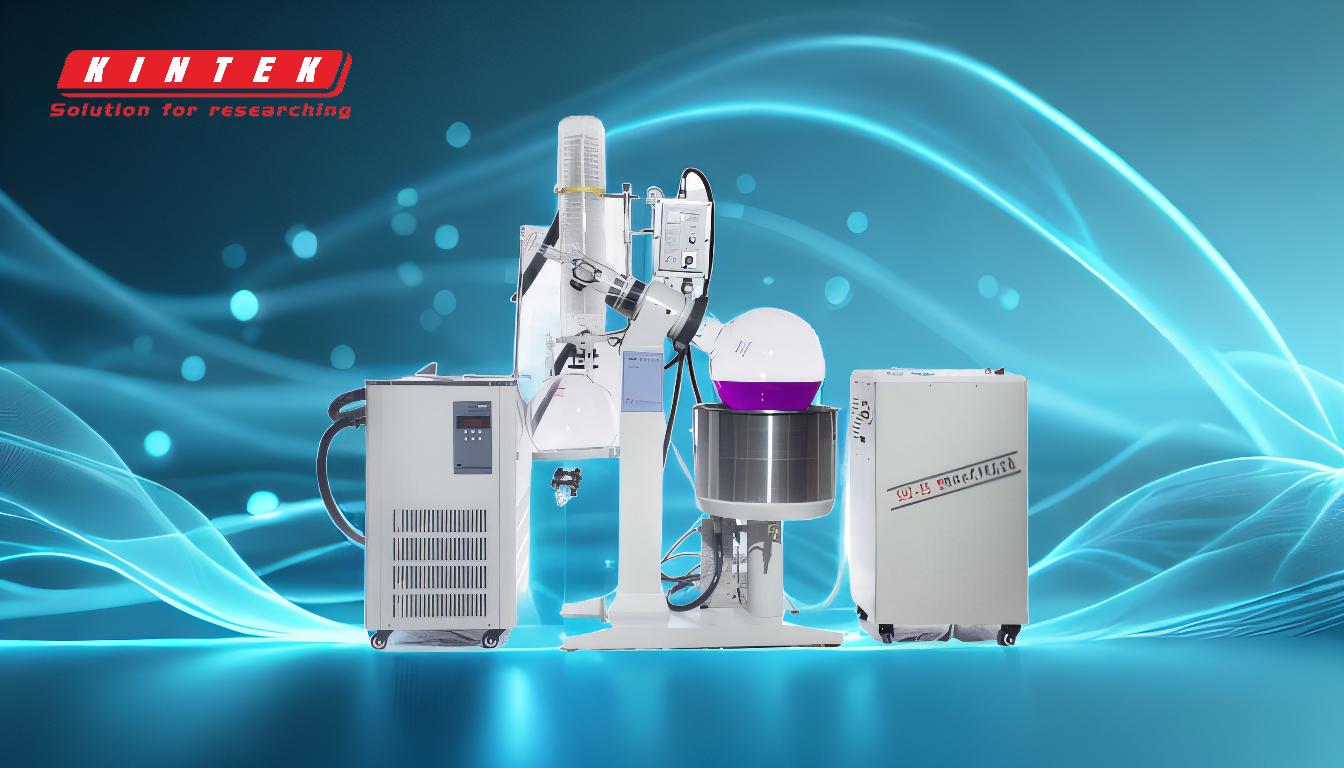A rotary evaporator, commonly referred to as a "rotovap," is a laboratory device used for efficient and gentle removal of solvents from samples through evaporation. Its functional principle revolves around three key mechanisms: rotation, reduced pressure (vacuum), and controlled heating. By rotating the evaporation flask, the device creates a thin film of the sample on the inner wall, increasing the surface area for evaporation. The vacuum system lowers the boiling point of the solvent, enabling evaporation at lower temperatures, which is crucial for heat-sensitive materials. The evaporated solvent is then condensed and collected in a separate flask, while the non-volatile components remain in the original flask. This process ensures rapid, efficient, and safe solvent removal, making rotary evaporators indispensable in chemistry, pharmaceuticals, and biochemistry labs.
Key Points Explained:

-
Rotation of the Evaporation Flask
- The evaporation flask is continuously rotated by a motorized system, typically at a controlled speed.
- Rotation creates a thin, uniform film of the sample on the inner wall of the flask, significantly increasing the surface area for evaporation.
- This mechanism ensures even heating and reduces the risk of "bumping," a phenomenon where sudden boiling can cause sample loss or contamination.
- The rotation also facilitates uniform mixing, which is particularly beneficial for heat-sensitive or volatile materials.
-
Reduced Pressure (Vacuum)
- A vacuum pump is used to create a reduced-pressure environment inside the system.
- Under reduced pressure, the boiling point of the solvent decreases, allowing it to evaporate at much lower temperatures than at atmospheric pressure.
- For example, solvents like water, dimethylformamide (DMF), and dimethyl sulfoxide (DMSO), which have high boiling points at atmospheric pressure, can be distilled at significantly lower temperatures (e.g., 50°C at 5 torr).
- This feature is critical for preserving the integrity of heat-sensitive compounds or analytes.
-
Controlled Heating
- The evaporation flask is partially immersed in a heated water or oil bath, providing consistent and controlled heating.
- The combination of heat and reduced pressure accelerates the evaporation process while maintaining a low temperature.
- The temperature of the bath is carefully regulated to ensure efficient evaporation without degrading the sample.
-
Condensation and Collection
- The evaporated solvent travels through a vapor duct into a condenser, typically a coiled glass tube cooled by a circulating coolant (e.g., water or refrigerant).
- The condenser cools the vapor, causing it to condense back into a liquid state.
- The condensed solvent is collected in a separate receiving flask, while the non-volatile components remain in the original evaporation flask.
- This separation process is highly efficient and ensures minimal loss of the desired sample.
-
Advantages of the Rotary Evaporator
- Efficiency: The combination of rotation, vacuum, and heating significantly speeds up the evaporation process compared to traditional methods.
- Gentle Processing: The ability to evaporate solvents at low temperatures protects heat-sensitive materials from degradation.
- Scalability: Rotary evaporators are available in various sizes, making them suitable for both small-scale laboratory work and larger industrial applications.
- Versatility: They can handle a wide range of solvents, including those with high boiling points, and are compatible with volatile and non-volatile compounds.
-
Applications of Rotary Evaporators
- Chemistry Labs: Used for solvent removal, concentration of solutions, and purification of compounds.
- Pharmaceutical Industry: Essential for drug discovery, formulation, and quality control processes.
- Food and Beverage Industry: Employed for extracting flavors, fragrances, and essential oils.
- Biochemistry and Molecular Biology: Used for concentrating protein solutions, removing solvents from samples, and preparing samples for analysis.
-
Operational Considerations
- Vacuum Level: The vacuum level must be carefully controlled to achieve the desired boiling point reduction without causing excessive foaming or bumping.
- Rotation Speed: The rotation speed should be optimized to create an even film without splashing or uneven heating.
- Coolant Temperature: The condenser coolant must be sufficiently cold to ensure efficient condensation of the solvent vapors.
- Safety: Proper handling of vacuum systems and solvents is essential to prevent accidents, such as implosion or exposure to hazardous vapors.
By combining these principles, a rotary evaporator provides a highly efficient, controlled, and gentle method for solvent removal, making it an essential tool in modern laboratories.
Summary Table:
| Key Feature | Description |
|---|---|
| Rotation | Creates a thin film for increased surface area, ensuring even heating. |
| Reduced Pressure | Lowers boiling points, enabling evaporation at lower temperatures. |
| Controlled Heating | Heated bath accelerates evaporation while maintaining low temperatures. |
| Condensation | Vapor is cooled and collected, separating solvents from non-volatile components. |
| Advantages | Efficient, gentle, scalable, and versatile for various solvents and compounds. |
| Applications | Chemistry, pharmaceuticals, food & beverage, and biochemistry labs. |
Enhance your lab's efficiency with a rotary evaporator—contact our experts today!












